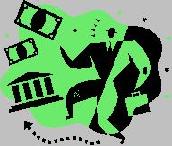
 |
|
| Financial Terms | |
| Old-line factoring |
|
Information about financial, finance, business, accounting, payroll, inventory, investment, money, inventory control, stock trading, financial advisor, tax advisor, credit.
Main Page: financial advisor, investment, inventory, business, tax advisor, accounting, financial, inventory control, Also see related: mortgage, homes, home insurance, homebuying, home financing, financing, real estate, homebuyer, condo, |
Definition of Old-line factoring
Old-line factoringfactoring arrangement that provides collection, insurance, and finance for accounts receivable.
Related Terms:Annualized holding period returnThe annual rate of return that when compounded t times, would have Bank lineline of credit granted by a bank to a customer. Buy-and-hold strategyA passive investment strategy with no active buying and selling of stocks from the Capital market line (CML)The line defined by every combination of the risk-free asset and the market portfolio. Cash flow time-lineline depicting the operating activities and cash flows for a firm over a particular period. Characteristic lineThe market model applied to a single security. The slope of the line is a security's beta. Conflict between bondholders and stockholdersThese two groups may have interests in a corporation that  Cross holdingsOne corporation holds shares in another firm. Demand line of creditA bank line of credit that enables a customer to borrow on a daily or on-demand basis. EquityholdersThose holding shares of the firm's equity. Euro lineslines of credit granted by banks (foreign or foreign branches of U.S. banks) for Eurocurrencies. FactoringSale of a firm's accounts receivable to a financial institution known as a factor. Gold exchange standardA system of fixing exchange rates adopted in the Bretton Woods agreement. It Gold standardAn international monetary system in which currencies are defined in terms of their gold Golden parachuteCompensation paid to top-level management by a target firm if a takeover occurs. Holder-of-record dateThe date on which holders of record in a firm's stock ledger are designated as the  Holding companyA corporation that owns enough voting stock in another firm to control management and Holding periodLength of time that an individual holds a security. Holding period returnThe rate of return over a given period. Investment product line (IPML)The line of required returns for investment projects as a function of beta Line of credit An informal arrangement between a bank and a customer establishing a maximum loan Linear programmingTechnique for finding the maximum value of some equation subject to stated linear constraints. Linear regressionA statistical technique for fitting a straight line to a set of data points. Log-linear least-squares methodA statistical technique for fitting a curve to a set of data points. One of the Line of creditAn informal arrangement between a bank and a customer establishing a maximum loan Maturity factoringfactoring arrangement that provides collection and insurance of accounts receivable. Monetary goldGold held by governmental authorities as a financial asset.  Mortgage pipelineThe period from the taking of applications from prospective mortgage borrowers to the Mortgage-pipeline riskThe risk associated with taking applications from prospective mortgage borrowers Overbought/oversold indicatorAn indicator that attempts to define when prices have moved too far and too Presold issue An issuethat is sold out before the coupon announcement. Revolving line of creditA bank line of credit on which the customer pays a commitment fee and can take Security characteristic lineA plot of the excess return on a security over the risk-free rate as a function of Security market lineline representing the relationship between expected return and market risk. Shareholders' equityThis is a company's total assets minus total liabilities. A company's net worth is the Shareholders' letterA section of an annual report where one can find jargon-free discussions by Simple linear regressionA regression analysis between only two variables, one dependent and the other explanatory. Simple linear trend modelAn extrapolative statistical model that asserts that earnings have a base level and StakeholdersAll parties that have an interest, financial or otherwise, in a firm - stockholders, creditors, Stockholder equityBalance sheet item that includes the book value of ownership in the corporation. It StockholderHolder of equity shares in a firm. Stockholder's booksSet of books kept by firm management for its annual report that follows Financial Stockholder's equityThe residual claims that stockholders have against a firm's assets, calculated by Straight line depreciationAn equal dollar amount of depreciation in each accounting period. Swingline facilityBank borrowing facility to provide finance while the firm replaces U.S. commercial paper T-period holding-period returnThe percentage return over the T-year period an investment lasts. Threshold for refinancingThe point when the WAC of an MBS is at a level to induce homeowners to Withholding taxA tax levied by a country of source on income paid, usually on dividends remitted to the Cost of goods soldThe cost of merchandise that a company sold this year. For manufacturing companies, the cost of raw RATE OF RETURN ON STOCKHOLDERS’ EQUITYThe percentage return or profit that management made on each dollar stockholders invested in a company. Here’s how you figure it: RATIO OF DEBT TO STOCKHOLDERS’ EQUITYA ratio that shows which group—creditors or stockholders—has the biggest stake in or the most control of a company: STOCKHOLDERS’ (OR OWNERS’) EQUITYThe value of the owners’ interests in a company. STRAIGHT-LINE DEPRECIATIONA depreciation method that depreciates an asset the same amount for each year of its estimated Cost of goods soldSee cost of sales. Line itemGeneric types of assets, liabilities, income or expense that are common to all businesses and Shareholders’ fundsThe capital invested in a business by the shareholders, including retained profits. Shareholder valueIncreasing the value of the business to its shareholders, achieved through a combination of Cost of goods soldThe cost of the items that were sold during the current period. Leasehold improvementsThe cost of improvements made to property that the company leases. Shareholders' equityThe total amount of contributed capital and retained earnings; synonymous with stockholders' equity. Stockholders' equityThe total amount of contributed capital and retained earnings; synonymous with shareholders’ equity. Straight-lineA method of depreciation. bottom lineA commonly used term that refers to the net income (profit) net income (also called the bottom line, earnings, net earnings, and netoperating earnings) stockholders' equity, statement of changes inAlthough often considered straight-line depreciationThis depreciation method allocates a uniform Security Market LineA graph illustrating the equilibrium relationship between the golden parachutea benefits package that is triggered by the hold missiona mission that attempts to protect the business line employeean employee who is directly responsible for linear programminga method of mathematical programming used to solve a problem that involves an objective function and multiple limiting factors or constraints long-term variable cost a cost that was traditionally viewed as a fixed cost Management Accounting Guidelines (MAGs)pronouncements of the Society of Management Accountants of product line marginsee segment margin red-line systeman inventory ordering system in which a red regression lineany line that goes through the means (or averages) of the set of observations for an independent variable and its dependent variables; mathematically, there is a line of “best fit,” which is the least squares regression line timelinerepresentation of the amounts and timing of all Cost of goods soldThe accumulated total of all costs used to create a product or service, FactoringThe sale of accounts receivable to a third party, with the third party bearing Leasehold improvementThis is any upgrade to leased property by a lessee that will be StockholderA person or entity that owns shares in a corporation. line of creditAgreement by a bank that a company may borrow at any time up to an established limit. security market lineRelationship between expected return and beta. stakeholderAnyone with a financial interest in the firm. straight-line depreciationConstant depreciation for each year of the asset’s accounting life. Cold-Turkey PolicyDecreasing inflation by immediately decreasing the money growth rate to a new, low rate. Contrast with gradualism. 45-Degree LineA line representing equilibrium in the goods and services market, on a diagram with aggregate demand on the vertical axis and aggregate supply on the horizontal axis. Gold StandardA fixed exchange rate system in which a currency is directly convertible into gold. Bill and Hold PracticesProducts that have been sold with an explicit agreement that delivery FactoringThe discounting, or sale at a discount, of receivables on a nonrecourse, notification Other-than-Temporary Decline in Market ValueThe standard used to describe a decline in market value that is not expected to recover. The use of the other-than-temporary description as Shareholders' EquityThe residual interest or owners' claims on the assets of a corporation Cost of goods soldThe charge to expense of the direct materials, direct labor, and PolicyholderThis is the person who owns a life insurance policy. This is usually the insured person, but it may also be a relative of the insured, a partnership or a corporation. There are instances in marriage breakup (or relationship breakup with dependent children) where appropriate life insurance on the support provider, owned and paid for by the ex-spouse receiving the support is an acceptable method of ensuring future security. FactoringType of financial service whereby a firm sells or transfers title to its accounts receivable to a factoring company, which then acts as principal, not as agent. Formalized Line of CreditA contractual commitment to make loans to a particular borrower up to a specified maximum during a specified period, usually one year. Line of CreditAn agreement negotiated between a borrower and a lender which establishes the maximum amount against which a borrower may draw. The agreement also sets out other conditions, such as how and when money borrowed against the line of credit is to be repaid. Operating Line of CreditA bank's commitment to make loans to a particular borrower up to a specified maximum for a specified period, usually one year. ShareholderOwner of one or more shares of stock in a corporation. Shareholder's EquityRepresents the total assets of a corporation less liabilities. Related to : financial, finance, business, accounting, payroll, inventory, investment, money, inventory control, stock trading, financial advisor, tax advisor, credit. |